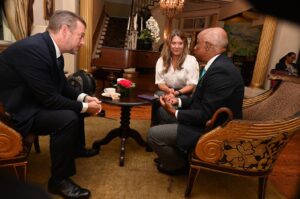
Spine-tingling adventure on giant lizard’s journey back to Jamaica
170-year-old specimen being handed over to IOJ May 22
THE 170-year-old lizard specimen that was repatriated from Scotland last month will be officially handed over to The Institute of Jamaica (IOJ) on May 22, bringing to an end a two-year process during which the artefact went missing, for a brief moment, at Glasgow International Airport on its way home.
“There will be an official handover ceremony between The Institute of Jamaica and The University of the West Indies (The UWI) for IOJ to keep the specimen,” Dr Shani Roper, The UWI’s museum curator, told the Jamaica Observer.
Dr Roper was among the five-member team from Jamaica which flew to Glasgow to collect and repatriate the specimen of a Jamaican giant galliwasp which was believed to have been collected in the 1850s.
It became part of the University of Glasgow collection in 1888, and its return to Jamaica has been described as the first repatriation of a natural history specimen in the Caribbean.
The repatriation was executed under a 2019 memorandum of understanding (MOU) between The UWI and the University of Glasgow, designed to foster collaboration in research and education and address the historical legacies of colonialism.
Dr Roper recalls the sequence of events leading to the eventual handover of the giant lizard in Glasgow.
In 2022 The Hunterian museum at Glasgow University mounted an exhibition called Curating Discomfort which, as the university explained on its website, “puts forward discomforting provocations and interventions to help us to understand that museums have perpetuated ideologies of white supremacy: a political, economic and cultural system in which white western ideas control the power of the texts, the material resources, and the actions that continue to underpin notions of cultural superiority”.
Additionally, it stated that, “colonial systems, such as the British Empire, used these ideologies to justify the enslavement and colonisation of peoples and lands around the world”.
The exhibition, Dr Roper explained, brought in community curators who did a dive into the collection.
One of those curators chose the galliwasp, setting off a chain of events starting with an e-mail from Michael Rutherford, zoology curator at The Hunterian, to Dr Roper and other colleges in Jamaica informing them of the existence of the galliwasp and that he thought it would be a good candidate for repatriation.
“I was aware that we didn’t have a galliwasp in our collection, so I wrote back to say ‘Absolutely’, and I contacted my colleagues at the Natural History Museum of Jamaica,” Roper told the Sunday Observer.
“We established a committee, including colleagues from The Hunterian; UWI; UWI museum; Department of Life Sciences, Mona campus; Natural History Museum of Jamaica, to determine how best to effect the repatriation of the specimen,” she explained.
“In June 2023 we had a webinar titled Repatriation, Natural History Collections and Knowleddge Co-Production: The Case of the Giant Jamaican Galliwasp. It served as a kind of pre-education engagement around it because, of course, it would require funding. The specimen would have to travel, and it wasn’t enough for us for the specimen to travel without that kind of public education component,” Roper said.
They eventually put together and submitted an application for funding to Glasgow-Caribbean Centre for Development Research, which was granted.
Funding was also provided by The UWI, allowing graduate students from the Department of Life Sciences to be included on the team, as the MOU between both universities requires research and knowledge production.
So on April 17, 2024 the team, comprising Roper; Dionne Newell, senior research officer in entomology at IOJ; Desireina Delancy, graduate student, The UWI, Mona; Dr Tannice Hall, entomologist and lecturer, life sciences, The UWI, Mona; and Elizabeth Morrison, zoologist curator at IOJ museum, left Jamaica for Scotland.
They arrived on April 18 and the following day participated in a conference titled Scotland and the World, which Dr Roper said basically discussed Scottish practices of repatriation.
When the time came for the specimen to be handed over to the Jamaicans, Dr Roper had the joy of having it placed in her hands.
“I was very excited. This was about 19 months of work, the arguments, counter-arguments, getting the visas and paperwork sorted,” she told the
Sunday Observer.
“I am co-president of Museums Association of the Caribbean and I’m deeply aware of the challenges. I know what the global debate is and I know where the Caribbean falls in that debate. So for me, just being able to be a part of such a historic process, to actually have a sense of what’s really required to push through something like this, and what it means for us as a region in terms of investing in museums and putting in infrastructure, and what it means for research and education, it has a very broad impact,” she explained.
Dr Roper said the specimen “was packaged for travel”. That involved taking it out of the ethanol-filled jar, soaking it and wrapping it in cheese cloth, after which it was vacuum-sealed and packaged multiple times.
That night she kept it in her room. The next day she placed it in her hand luggage for the flight back to Jamaica.
But at the Glasgow airport Roper had a bit of a scare.
“When I got to the first security checkpoint I declared that I had it. I said ‘I have a lizard with me; it’s vacuum-sealed, it’s not in any fluids, etc.’ They said ‘No problem.’ I put it in a container and I remember I had put my scarf with it, because it was cold, and I sent it off first and then sent everything else through.
“I get through the security checkpoint and it’s gone. So I’m standing there and I’m confused because in my mind it doesn’t make sense that someone would walk away with it – because we have a picture and it’s not the most photogenic specimen in the world. So I was confused because in my head I only had one task, which was to bring it back to Jamaica,” Dr Roper related.
“So I asked a gentleman I said ‘Hi, I’m looking for our lizard specimen,’ and he said, ‘Oh, no don’t worry about it.’ But I said, ‘No sir, I have documentation, do you guys need to see it?’ He said, ‘No, no, no it will soon be back,’ ” Dr Roper recalled.
It turned out that a curious female security worker had taken the specimen to her supervisor.
“When she brought it back she said to me, ‘I’m so sorry, but we’ve never had a lizard come through here before and because I was so curious I took it to my supervisor to confirm.’ She said, ‘We didn’t put it through the X-ray or anything like that; we just wanted to make sure that it was okay.’
She then asked, ‘Could you tell me some more about this lizard?’ I explained to her that it was being repatriated, it’s extinct, and I showed her some of the press coverage,” Dr Roper shared.
“I didn’t have any issues when I went to Gatwick,” she added.
While the Glasgow airport incident triggered a bit of an alarm for Dr Roper, she admitted that, “It was a very interesting experience” that turned out to be a useful educational episode.
Now, ahead of Wednesday’s handover to the IOJ, the specimen has to go through the process of being put back into ethanol, and the individuals charged with that responsibility had to ensure that they got the correct breakdown of the chemical.
Overall though, Dr Roper is extremely pleased, especially with the state of the specimen which she had seen only in photos before.
“It’s very well preserved. I was pleasantly surprised,” she told the Sunday Observer.























